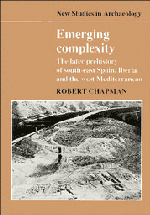Book contents
- Frontmatter
- Contents
- List of figures
- List of tables
- Preface
- 1 Two tribes: questions of theory, scale and explanation
- 2 Hello, goodbye: Iberian prehistory and traditional archaeology
- 3 Another one bites the dust: the implications of the absolute chronology
- 4 Getting better: south-east Spain, the cultural framework 5000–500 bc
- 5 Dancin' in the dark? Adaptation and intensification in south–east Spain
- 6 Centrefield: recent models of intensification and cultural change in south-east Spain
- 7 Into the groove: system scale and technological innovation in south-east Spain
- 8 Out of reach? Complexity, interaction and integration in south-east Spain
- 9 Eliminator: models and the archaeological record in south-east Spain
- 10 Strong persuader: intensification and interaction in Iberia and the west Mediterranean
- 11 With or without you: variability, evaluation and complexity
- Bibliography
- Index
10 - Strong persuader: intensification and interaction in Iberia and the west Mediterranean
Published online by Cambridge University Press: 05 March 2012
- Frontmatter
- Contents
- List of figures
- List of tables
- Preface
- 1 Two tribes: questions of theory, scale and explanation
- 2 Hello, goodbye: Iberian prehistory and traditional archaeology
- 3 Another one bites the dust: the implications of the absolute chronology
- 4 Getting better: south-east Spain, the cultural framework 5000–500 bc
- 5 Dancin' in the dark? Adaptation and intensification in south–east Spain
- 6 Centrefield: recent models of intensification and cultural change in south-east Spain
- 7 Into the groove: system scale and technological innovation in south-east Spain
- 8 Out of reach? Complexity, interaction and integration in south-east Spain
- 9 Eliminator: models and the archaeological record in south-east Spain
- 10 Strong persuader: intensification and interaction in Iberia and the west Mediterranean
- 11 With or without you: variability, evaluation and complexity
- Bibliography
- Index
Summary
Comparison lies at the heart of the social sciences. As archaeologists, we wish to understand the evolution of human cultures. Comparison of past cultures highlights order and pattern in the data, as well as variability, and both require explanation. From the point of view of the model of explanation outlined in chapter 1, comparison also enables us to assess the utility and comprehensiveness of our theories. A theory of the evolution of cultural complexity which applied only to one area would not be thought very successful. Similarly, a theory of cultural complexity which did not help us to understand those contexts in which complexity did not emerge would also be found wanting.
In chapter 1, I summarised arguments which analysed the interrelationships between six variables (intensification, system scale, technological innovation, complexity, interaction and integration) in the evolution of complex societies. In chapters 5, 7 and 8, I have tried to operationalise and measure these variables for the Copper and Bronze Ages of south-east Spain. This has focused attention on the strengths and weaknesses of the archaeological record of this area, and of the current explanations for that record. The aim of the present chapter is to compare the archaeological record of south-east Spain with that of other areas of Iberia and the west Mediterranean. Is south-east Spain the only area in which complex societies evolved before the emergence of the Etruscan state in the first millennium be?
- Type
- Chapter
- Information
- Emerging ComplexityThe Later Prehistory of South-East Spain, Iberia and the West Mediterranean, pp. 220 - 267Publisher: Cambridge University PressPrint publication year: 1990



